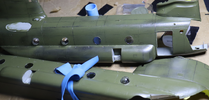STARMAKER.REBEL
Active Member
- Joined
- Oct 2, 2024
- Messages
- 362
I find that cementing parts together that have been painted before cementing don't stick together well. MR Cement doesn't stick well on painted and neither does the Tube of CEMENT that I can't seem to find in the abyss of my bedroom. I'm using Gorilla Superglue and that works well on painted parts. My bottle is almost empty though.







